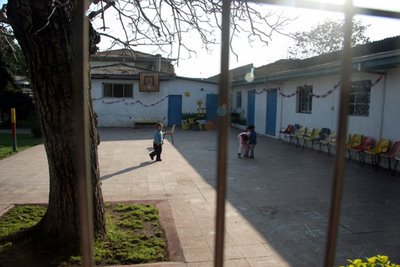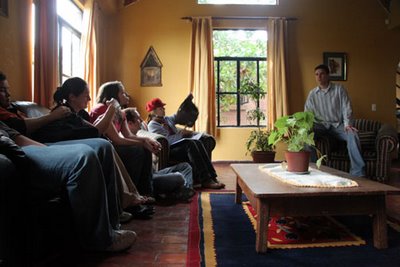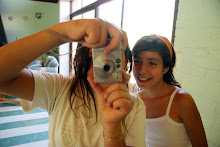
We live in a cluster of buildings situated around a couple of adjoining patios. While there is a church immediately next door to the complex, and the girls say their prayers before meals and attend catechism classes, I don't know if the hogar is funded privately or through the government. In comparison to other hogares, I believe that we are very fortunate, and have access to all of our essentials and even more. Still, however, resources are scarce. The cheerfully painted walls around the patio brighten the look of the place, but there is still a lot of pain and anger. Those in charge of the hogar believe in keeping the girls occupied, which definitely helps with their behaviors and attitudes. We clean multiple times a day, and everyone shares in the daily maintenance of our lives here. The tias are the bosses here, we have two day tias and two night tias. Each shift lasts 12 hours and consists of everything one might need to do to raise 26 girls. Needless to say, they are quite busy.
The girls look to us volunteers for social, cultural, recreational, and supplemental educational projects. Our website outlines many of our current projects, but we are always starting new ones as more volunteers arrive with fresh energy and ideas. One of our biggest projects is called Liga de Futbol and organizes soccer tournaments in which teams from different hogars can play against one another. This program is important because not only does it give these children a chance to leave their hogar for a full Saturday of fun (with a meal included) but they also can meet other children from other hogars and experience healthy competition and teamwork. The girls at San Francisco de Regis love to play soccer, but I had heard that they never win any games. I found out why the other day: this is their only soccer ball. I dug it out of a closet, deflated, and the girls immediately gathered around me to play with it. I told them after lunch I would go to the gas station to fill the ball, or pelota, up with air, and they could barely contain their excitement. You can imagine how I felt when the worker at the closest gas station told me there was a hole in the ball, that he couldn't inflate it. I had to walk back to the girls and tell them I would explain the rules of soccer to them another day, when we had a better ball. They looked at me as if they had heard this all before.

Luckily we do have some supplies in a closet here in our set of rooms on the complex. I found a few balls of yarn, and while I'd rather teach the girls to crochet or something more useful, we only had yarn at this point. So I decided to teach them fingerknitting instead. The first girl to learn, I will call her Ana, told me that she didn't think that she would be able to do it. Ana is a bit shy, and being maybe 9 years old, a little awkward. She insisted she would not be able to learn. Lena and I sat with her, and within minutes she insisted she didn't need our help. Other girls came and went, fingerknitting as long as their rather short attention spans, but Ana sat in the sun in her chair all afternoon, intent on finishing the whole ball of yarn. And when she did, and the other girls poured compliments over her finished piece, she couldn't stop smiling.















